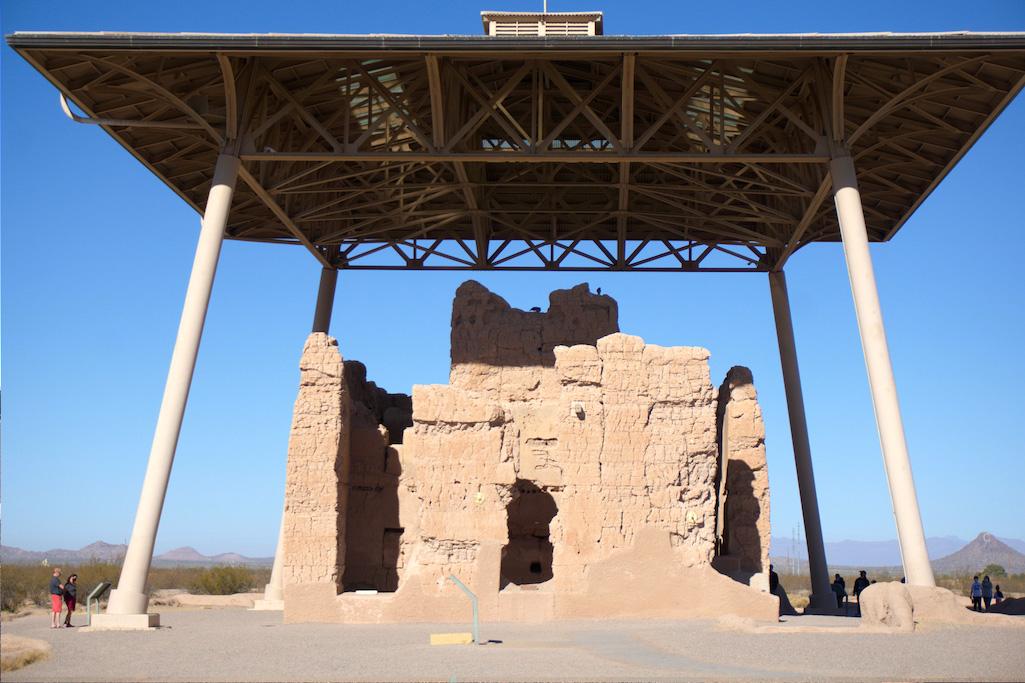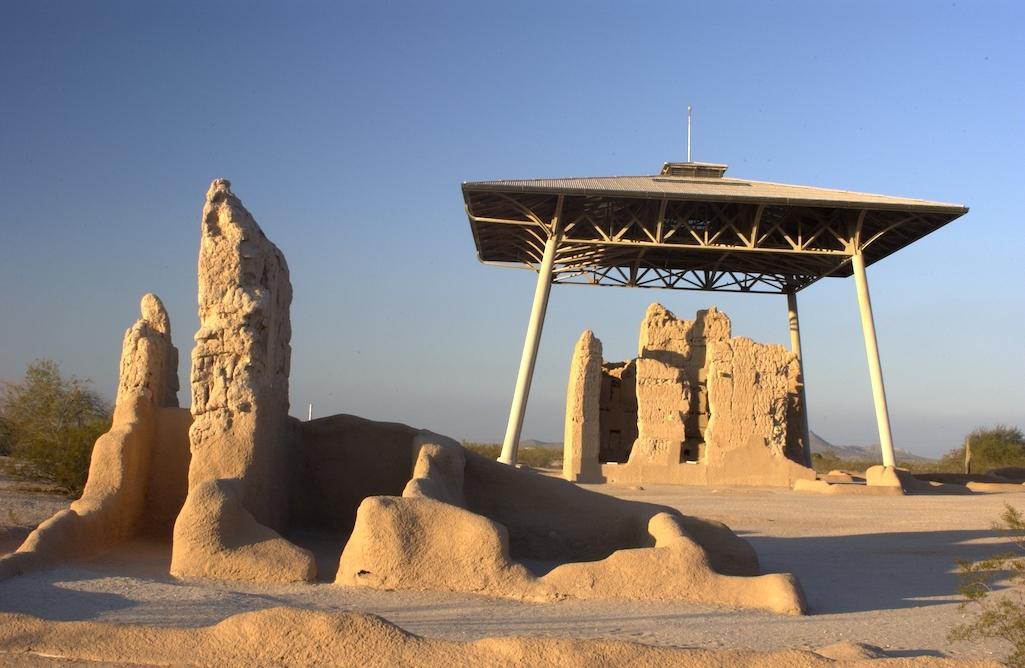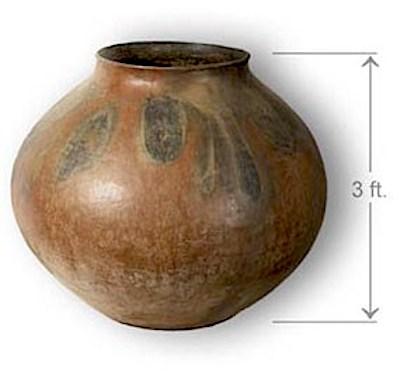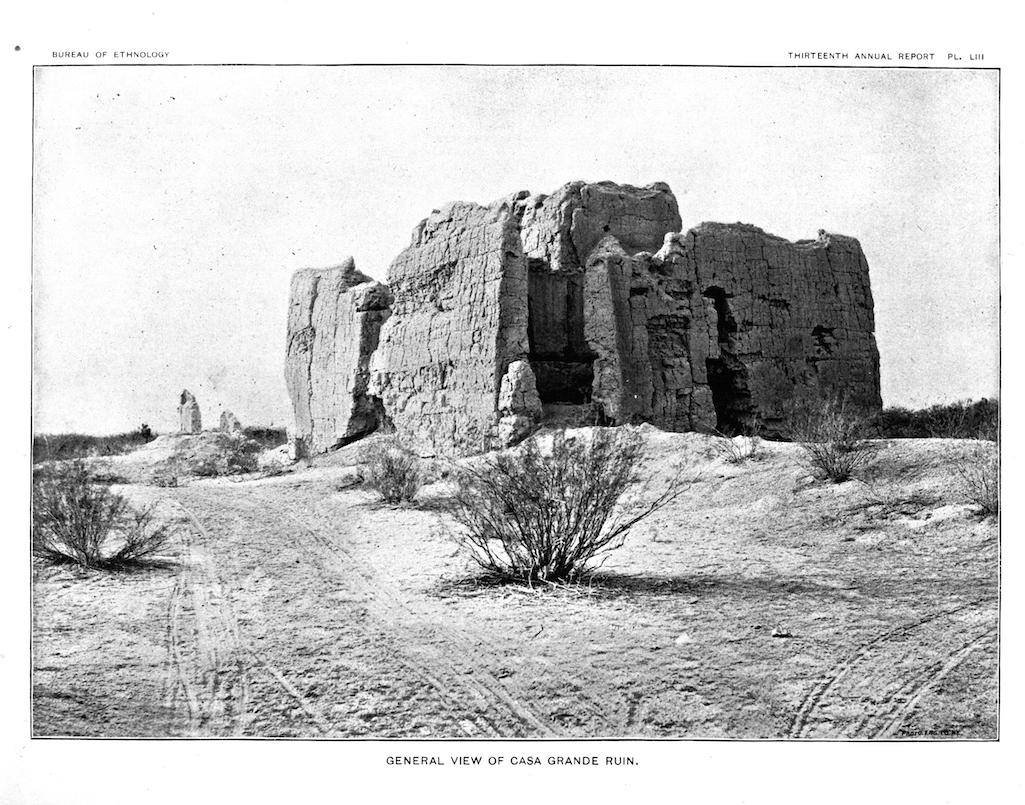
Nearly four stories tall (see visitors on left for perspective), the Great House at Casa Grande National Monument is a testament to an enduring desert culture/Jess Repanshek
Rounding a bend on Arizona 387, we leave the San Tan Mountains behind and cross onto a wide basin that stretches off to the Superstition Mountains. Most of the vegetation to be seen is a collection of dry desert bushes, the only sort of plants that somehow manage to thrive on the meager annual rainfall. The only shade to be found is under boulders or nestled right up against the mountains’ cliff faces.
“What a curious place to build a house,” I think.
My fiancée and I had left Phoenix earlier in the day, and as we exit the mountains and look at the desert spreading out before us, I’m trying to envision the daily lives of the ancestral Sonoran Desert people who lived here nearly a thousand years ago. The landscape streaming past my window is a craggy, unforgiving, cactus-filled, rumpled desert, and I find it hard to imagine anyone living out there by choice. However, as we’re about to find out, people actually prospered here in this rough environment for quite some time.
As the basin opens before us, vast fields of cotton fill the landscape, a notable change from the rough terrain we had just driven through. Cotton fields eventually give way to parking lots, and we pull up to a stoplight. I’m presented with two choices: to the left, a WalMart shopping megacenter. But to my right, a mysterious desert adventure at a massive abandoned monument.
Of course, we turn right toward Casa Grande Ruins National Monument. Our destination is an unusual, nearly four-story-tall structure built in the middle of desert, known locally as Sivan Vahkih. This curious oddity on the desert skyline, with its smooth walls and precision craftsmanship, leaves me wondering what else exists out here in the desert that I don’t know about?

The Great House was the center of a compound built by ancestral Sonoran Desert people/NPS
The sun beams down as we walk from informative sign to informative sign on our self-guided tour. The monument is open and operating during the pandemic, but the tour guides remain at the front desk and hand out maps in the shade while happily answering questions posed by the handfuls of visitors milling about.
It may be bright out, but an outdoor adventure is a welcome change from the months staring at the same four walls, working from home, and social distancing. Towering before us is a different set of four walls, a set we’ve never seen before. These walls, a bit worse for wear from vandalism and UV exposure, belong to the Great House, the main attraction at Casa Grande Ruins National Monument.
The first written account of the discovery of this building dates to the late 1600s. Father Kino, a Jesuit missionary from Spain spreading Christianity and European goods throughout the Southwest, was the first of many travelers to visit this site in modern history. Journeying west from present-day New Mexico along the Gila River, the padre was traveling with members from a local Pima tribe who wanted to show him what they referred to as “hottai ki” — a great abandoned structure seemingly in the middle of nowhere.
Kino’s entourage investigated the complex, which boasted a focal point as large as the biggest churches they knew back home. In the surrounding landscape they saw an array of smaller, more dilapidated ruins. An extensive canal system cut across the landscape, leading for miles across the desert from the Gila River and up to the ancient compound. Father Kino dubbed this the “Casa Grande,” a term that translates to “The Great House,” and it stuck.

Casa Grande is one of the largest prehistoric structures ever found in North America, but archaeologists still aren' sure why it was built/NPS file
As we wander around the ruins, archaeological fascination washes over me. The sheer amount of ingenuity and effort that it took for people to plan and build this creation is impressive. The inhabitants of the Casa Grande ruins created miles and miles of canals through harsh desert soil. It would have required stone tools and hard labor to dig canals like the one leading to the Casa Grande ruins.
It had to be a back-breaking chore, but one that allowed them to master the landscape, irrigate great crops of corn and cotton, and flow life-sustaining water across the arid desert. They found the soil could be re-used, shaped and molded like concrete to erect magnificent structures, monuments to how highly regarded this desolate area was to those who made it their home hundreds of years ago.
So unique is this structure and surrounding community, and so industrious and astute were its creators, that in 1892 it because the first prehistoric and cultural site to be protected in the United States when President Benjamin Harrison created the Casa Grande Ruin Reservation.

Large pottery vessels were used for water and food storage and for cooking. When different types of temper were added, a vessel became more porous and acted as an evaporative cooler, producing chilled water. This olla was found near the Great House and is 3 feet tall.--National Park Service
Look the ruins up on Google Maps and you’ll find the main building at the Casa Grande Ruins is called Sivan Vahkih, a name given to it by the O’odham, descendants of the Ancestral People of the Sonoran Desert. Radio-carbon dating shows the Great House was erected around 1300 CE, but evidence shows that these first masters of the desert had lived along the Gila River basin as hunter-gatherers for centuries prior to that. Once they established their vast canal system, they were able to settle down, grow crops, and make a permanent community. Casa Grande was a testament to their successes.
Life back then, though labor intensive, still must have been much simpler than today, with the sunrise and sunsets the only time clocks. Much of daily life for men involved hunting, building and maintaining canals, as well as growing and harvesting crops. Others would spend their time creating unique art in the plaza, an open-air common area surrounding Sivan Vahkih. Their art took the form of pottery featuring a unique red-on-buff aesthetic common to the area. They found that they could craft jewelry by applying tree sap and fermented cactus juice to seashells they got from trade routes with coastal areas. This combination of materials allowed them to create unique designs on the shells, which could then be traded for other goods or worn at celebrations.
Walking around the monument, I notice light glinting through upper windows and portholes, cascading down onto the dirt floors of the lower levels of the building. There are key cutouts strategically placed in a few sections of the higher walls. The walls themselves are oriented squarely with the cardinal directions, so it seems to me that this may have been a temple of sorts, a purposeful structure aligned to the mechanisms of the solar system.

Casa Grande around 1890, two years before President Benjamin Harrison protected it/Bureau of American Anthropology
Though this structure has stood for lifetimes, time has taken its toll. Cracks can be seen throughout the structure, degrading the once-pristine plaster into decaying ruins and revealing much of its inner construction. Most of the original wood frame has rotted away, leaving small holes that are now happily inhabited by pigeons, some of the only wildlife we saw on this journey.
I had to wonder how the creators of the Casa Grande would come to be in possession of the great quantities of lumber needed for this construction. There aren’t trees to be seen for miles, and yet this building has hundreds of thick, 10-foot-long fir and pine timbers giving structure to the walls and floors. They must have had great relations with neighbors near and far to be able to gather such a large amount of wood. The nearest forests are 50 or so miles away, so this timber possibly was floated down rivers and along the canals to arrive here. Similar canal engineering is found in Pueblo Grande and Mesa Grande, two other historical sites found in the Phoenix area. In fact, these irrigation techniques and trade connections may have helped create thriving settlements all along the Gila River and up the Salt River to the north.
The hot, dusty environment quickly makes you parched, as the original inhabitants of this landscape must have been accustomed. While I can simply walk back to my car for a second bottle of water, they had to rely on the nearby Gila River. The river was not just as source of life-giving water for them; it was a sort of crossroads for those traveling through this arid part of what we call the American Southwest. With these trade routes, crops, and canal systems, they were able to nourish a greatly prosperous community, even in the middle of such a harsh environment.
In real estate, it’s all about “location, location, location…,” and that really seems to be one of the key ingredients that helped this area to thrive for so long. This was a key stop in trade routes from Mexico to present-day California. Centuries later it was a stopping place for the Transcontinental railroad coming across from San Diego to New Mexico. Across the parking lot to the north, there’s another nod to the area’s historical significance — a set of ballcourts and platform mounds commonly found in Aztec civilizations.
Whether it’s hunter-gatherers, Spanish missionaries, railroad workers, desert vandals, or modern-day philanthropists, this small structure of sand and desert concrete has garnered much attention over the years, and for good reason. But why was such a structure built in the first place? Was it a temple? A palace? Simply offices? All we have to go on are the clues left in these ruins.

Why was the Great House built, and what was it used for?/Jess Repanshek
The true purpose of the Casa Grande Ruins remains a mystery and will probably stay that way. We know that humans flourished in this environment for centuries, but somewhere around 1450 CE the ancient Sonoran Desert people simply vanished, leaving no texts, no bodies, and no explanations of any kind. Whether this exodus was caused by droughts, floods, war, famine, or perhaps alien abductions, the history of the people who created this unique structure has disappeared into the sands of time, leaving us only to ponder our own existence.
The history of this land has more than meets the eye. What curious series of events would make a society like this thrive, and then disappear into nothingness? What will our ruins tell future archaeologists? Will our lives look as simple to them, as these ancient people’s look to ours?



Comments
Interesting article. Someday I'll get to visit!
The first written account of the discovery of this building BY A EUROPEAN dates to the late 1600s. Obviously, members of the local Pima tribe and probably many other people saw Sivan Vankih before Father Kino did. His arrival didn't constitute a true discovery.